Teachers' Domain - Digital Media for the Classroom and Professional Development
User: Preview
Community colleges and technical schools across the country supply advanced technology industries with the competent and adaptable work force they need to compete in global markets. These two-year programs are designed to develop the academic potential of incoming students and the skills employers value when hiring for their companies. To get the most out of the training they’ll receive, students need to come prepared. That’s where you come in.
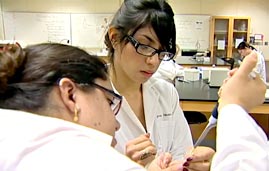
The National Science Foundation funds advanced technological education (ATE) centers across the country. The directors of these centers stress that high school students should demonstrate several key competencies before they begin a two-year degree program. While possessing certain skills and know-how prepares students for their chosen curricular path, it can also help steer them to a career path. These competencies include:
In this lesson, you’ll use videos and interactive activities to learn how the competencies listed above relate to ATE. You’ll see how various skills are employed in real-world scenarios and better understand how to incorporate this information when planning your curriculum. You will answer questions and take notes throughout the session—record your answers in the space provided and click "save notes." You will conclude by planning next steps that will help prepare your students for entering an advanced technological program after high school.
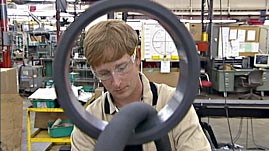
Video: 1m 33s
Many students learn the fundamentals of science and mathematics from classroom lessons and textbooks. However, by industry standards, what's more critical is knowing how to apply science and mathematics to solve problems and improve products.
Community colleges and technical schools offer hands-on learning environments for students. Labs give students the opportunity to use the actual equipment and work on problems that technical professionals face, so that they can see how science and mathematics have practical applications in real-life businesses.
In this video, meet Travis Blackwell, a field service engineer with ESAB Equipment. As his employer explains, science and mathematics are the foundation on which people like Travis build the technical skills that ultimately ensure their success in the workplace.
Click "View" on the left to watch the video.
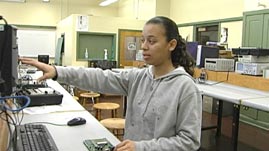
Video: 2m 47s
Biomedical technicians perform functions that are essential to hospital operations. To keep systems running, they apply technical know-how founded in their understanding of science and mathematics.
In this video, watch as Benjamin Franklin Institute of Technology student Monica Colòn discusses her strength with numbers and how hands-on training is preparing her for a career as a biomedical technician.
Click "View" on the left to watch the video.
After watching the video, prepare some discussion questions for your class concerning applied science and mathematics. For example, you might brainstorm how physics or mathematics is used in product development, or how an understanding of biology or general science can be applied in the workplace.
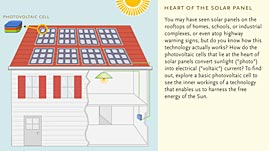
Interactive
Underlying advanced technology is a basic understanding of systems. Systems are collections of parts that function together to create a working mechanism. By being able to conceptualize how independent parts work together to make up a whole system, a technician can get right to work diagnosing problems, making repairs, and even recommending improvements.
In this interactive activity, take a look inside a solar cell to learn how this kind of electrical system functions as an assembly of its component parts and as part of the larger electromagnetic system. Solar cells—also called photovoltaic cells—have a variety of applications, from personal electronic devices (such as calculators, cell phone chargers, and bicycle lights) to utility-scale electricity generation at power plants and consumer-scale electricity generation in homes.
Click "View" on the left to explore the interactive activity.

Interactive
Closed-loop systems are found in many types of automated manufacturing processes. They ensure that desired outcomes are achieved—such as producing a high volume of goods of a consistent quality. This interactive activity describes the elements of a closed-loop system. An animation illustrates typical components and how signals control the operation of the system. The activity also allows you to compare the animation to a standard block diagram, which illustrates the various elements of a closed-loop system in a simplified form.
Click "View" on the left to explore the interactive activity.
After going through the interactive, brainstorm a classroom activity that asks your students to diagram a closed-loop system. You may use the preceding interactive as an illustration and then choose one or both of the descriptions provided in Diagram a Closed-Loop System (PDF). Or, you may develop an idea of your own.
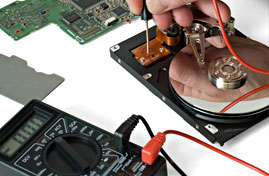
You have seen how Travis and Monica have learned enough about how their equipment works that they can fix or “debug” problems as they arise. Troubleshooting is figuring out the cause of the problem when things aren’t working right. Good troubleshooters are able to think about their systems as a whole, know the systems’ components, and conceptualize how these components interact to produce an output. They can then apply their skills to develop a process that solves the problem.
Write down some ways for your students to practice troubleshooting. For example, in a high school classroom, you might be able to troubleshoot an electric circuit or analyze a simple computer program that contains a glitch. First, give students a diagram that explains the system design. Next, present them with a “problem”—something that is not working within that system. Have students determine where things may have gone wrong, explain their reasoning, and recommend how to fix the problem.
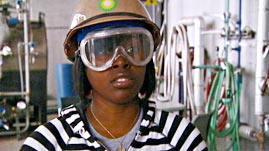
Video: 3m 39s
While “hard” (technical) skills have always been sought after in advanced technology fields, employers today are putting ever-greater value on a job applicant’s “soft” skills. These include strong written and spoken communication, creative thinking, and the ability to work well in teams. In the workplace, skills like these are essential to maintaining internal relationships with fellow employees and external relationships with vendors and customers.
In this video, learn why so many companies target well-rounded candidates in their recruiting—even those in industries that are as machinery-oriented as process technology.
Click "View" on the left to watch the video.
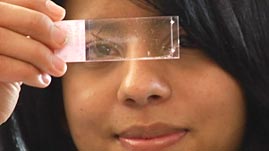
Video: 3m 25s
As you have seen, while technical aptitude and a solid foundation in science and mathematics remain important, so is coursework in social sciences such as communications, psychology, and sociology. This video features Sandra, a research assistant who works in the cutting-edge field of biotechnology. For all her proven technical skills, it’s her soft skills that have helped her excel in her field. These include a desire to learn, a willingness to collaborate with others, and curiosity about how things work.
Click "View" on the left to watch the video.
Prepare some ideas for a classroom discussion that will help demonstrate to students the value of soft skills in the workplace. For example, you might start by asking students to identify the skills and characteristics that Sandra exhibited in the video that make her such a valuable employee. You might then ask students to relate a personal experience in which they had to use effective communication skills to rectify a situation.

Video: 2m 46s
Nearly every job today requires computer skills. In advanced technology fields, workers can use these skills to:
In this video, see how agricultural workers rely on computerized data to guide tractors through planted fields and make better planting decisions. Click "View" on the left to watch the video.
Once students reach community college or technical school, they’ll refine computer skills pertinent to their chosen career path. But first, they need to learn the basics of operating computers and managing data.
Develop a classroom activity that can help your students improve their computer and data management skills. The activity could be as simple as defining a spreadsheet and inputting survey results or measurements, or developing a database that contains a parts inventory for your laboratory or for a fictitious manufacturer.
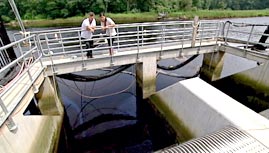
Video: 4m 16s
ATE programs recognize how important it is for students to develop skills that can be directly applied to the job functions they’ll perform. To help accomplish this, they train students in the kinds of problems they’ll face and on the equipment they’ll use in the workplace. When graduates of these programs are hired, they are ready for the job and can contribute right away.
In this video, plant worker Michael Poitras, who started working at a water treatment facility as a community college intern, takes us on a tour of the facility where he works. While explaining how brackish water is purified, he details how he has been able to integrate the skills and concepts he learned at his community college into a real-world setting.
Click "View" on the left to watch the video.

Video: 4m 32s
Competitions offer another way for students to apply science, mathematics, and their soft skills. Participants can appreciate how important creativity, the design process, problem solving, and teamwork are to the overall success of their efforts.
In this video, high school students participate in a technology competition and learn about how plastic products are made.
Click "View" on the left to watch the video.

In this lesson, you have learned about several competencies that high school students interested in advanced technology should develop before they enroll in a community college or technical school.
Now it’s time to review your responses in previous sections and to develop a plan. Click “review my work” above and view or print out the screen that pops up. Then click Preparing Your Students for Advanced Technological Education—Next Steps (PDF) to begin planning your next steps.
Math formula ©treenabeena/Fotolia [top left]
Quantum optics lab ©lightpoet/Fotolia [middle right]
Scientist at computer ©Image Source/Fotolia [bottom right]
Students at computer ©Corbis/Fotolia [bottom left]
ATETV
Pellet Productions, Inc.
AIME:
Male student working with teacher [top right]
Female student [middle left]
Teachers' Domain, Preparing Your Students for Advanced Technological Education, published May 18, 2012, retrieved on ,
http://www.teachersdomain.org/resource/ate10.ate.pd.splskills/
Media Type:
Self-paced Lesson
WGBH is trying to develop materials that better meet the needs of our users. Please take this brief survey to share how you use these resources and to provide feedback on your experiences using these materials. Take the Survey!
In this lesson designed for professional development, learn about the technical skills and “soft” skills used in advanced technology and ways you as a high school teacher might prepare your students for related educational and career pathways. You will watch videos, explore interactive activities, and answer content-related questions to gain insights as to which key competencies students should develop before entering a two-year degree program. You’ll also see how various skills are employed in real-world scenarios and become better prepared yourself to incorporate this information in planning your curriculum.
To help improve this service, please report and describe any standards correlations that you find to be inaccurate.
Academic standards correlations on Teachers' Domain use the Achievement Standards Network (ASN) database of state and national standards, provided to NSDL projects courtesy of JES & Co.
![]()
We assign reference terms to each statement within a standards document and to each media resource, and correlations are based upon matches of these terms for a given grade band. If a particular standards document of interest to you is not displayed yet, it most likely has not yet been processed by ASN or by Teachers' Domain. We will be adding social studies and arts correlations over the coming year, and also will be increasing the specificity of alignment.
You must be signed in to see standards matches for your state.
 Loading Standards
Loading Standards Teachers' Domain is proud to be a Pathways portal to the National Science Digital Library.
Teachers' Domain is proud to be a Pathways portal to the National Science Digital Library.
Major funding for Teachers' Domain was provided by the National Science Foundation.
Teachers Domain® Home | Change Edition
About Teachers' Domain | Contact Us | Privacy Policy | Terms of Use
Teachers' Domain: © 2002-2025 WGBH Educational Foundation | shopPBS Educational Media


